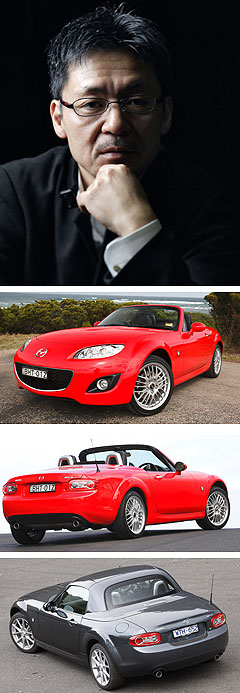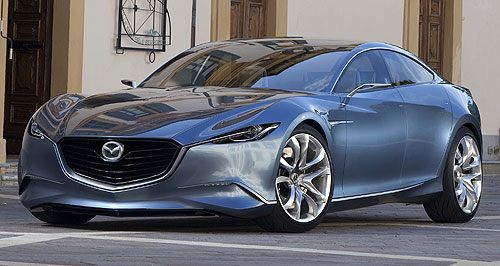Make / Model Search
Future models - MazdaShinari shapes next Mazda MX-5Fresh lines: Look hard, and you might see Mazda's next MX-5 in the Shinari concept's sleek lines. Mazda’s Kodo Energetic Motion design mantra moulds its next two-seat roadster30 Jun 2011 MAZDA design boss Ikuo Maeda has admitted that the next-generation MX-5 convertible is proving to be one of his toughest assignments of his career. Speaking to select Australian and New Zealand journalists at a Mazda Design Forum in Melbourne this week, the general manager of the company’s design division also revealed the Shinari concept car first unveiled at the Paris motor show last year heralds the brand’s Kodo ‘energetic motion’ form for all future Mazdas of the foreseeable future. With the help of computer generated images, Mr Maeda illustrated that even though the tense, muscular, cheetah-like design form of Kodo as seen on the Shinari can be applied to a convertible like the MX-5, it must retain the basic tradition, heritage, and character of the iconic roadster if it is to be considered a success. “I think the MX-5 will be tough because it we have to consider the heritage as well as move forward,” he told GoAuto. “The MX-5 is its own brand within the Mazda brand so we have to be very careful with what we do. “But it will also be the most changed MX-5 … with less weight, more compact, but still simple too.” While not divulging specific details about the future model that is due in about 2013, Mr Maeda confirmed that the fourth generation two-seater rear-drive roadster will be shorter, with less rear overhang and a lower slung stance than the existing NC MX-5 released in 2005.  Left: Mazda's Ikuo Maeda. Below: Mazda MX-5. Left: Mazda's Ikuo Maeda. Below: Mazda MX-5.As with all recent Mazda passenger cars of late, it will be considerably lighter to help achieve significantly improved performance and drivetrain efficiency. One of the mantras of the NC was its ‘gram by gram’ mass reduction drive that shaved 8gm from the weight of the interior rear vision mirror. Greater aerodynamic attention to detail will be evident in the way the future model’s underbody is expected to be far smoother than before to aid wind flow. While Mr Maeda stopped short of announcing a production or on-sale date for the new MX-5, he did say that there would not be anything to communicate for at least the next few months – but that we should expect to see something within “two years – maybe”. Espousing the curvaceous front guards of the Shinari, with a line of LED daytime driving lights connecting both headlights via the lower trailing edge of the traditional five-point Mazda grille, the computer-generated MX-5 rendering highlighted a dramatic shift away from the simplicity of today’s roadster. Other styling highlights include a flared line that connects the bold rear wheel arches with the back bumper to create a more muscular yet contemporary stance, while a complex interplay of angles results in a rear upswing of the convertible’s shoulder line. Along with the truncated tail and cab-backward profile, a sort of early BMW Z4 meets current MX-5 flavour infuses the rendering’s finished product. How similar to the actual production car it is nobody at Mazda would say, with a playful Mr Maeda guessing that it was between “25 per cent and 85 per cent” accurate. He also emphasised that design work for the next MX-5 is an ongoing assignment right now with “much work still to be done.” Mr Maeda said that although the Shinari concept was a three-box four-door sedan and the production MX-5 a two-seater convertible, the same Kodo design principles applied. “The basic form language and construction between should be changeable (no matter what the vehicle is),” he said. “Kodo is about proportion first and then adding the character after.” The new Energetic Motion form is here to stay, Mr Maeda added, for as long as he is employed in the capacity of design at Mazda. “Kodo will be with Mazda for as long as I am alive,” he said. “It will be part of every Mazda vehicle from now on.” A 28-year veteran at Mazda, and chief designer of the current Mazda2 and RX-8, Mr Maeda has followed in the footsteps of his father Matasaburo Maeda, whose achievements among many was the look of the original RX-7 of 1978. “Bringing back the RX-7 is my dream,” Mr Maeda jnr said.  All future models Alfa Romeo Alfa Romeo Abarth Abarth Alpine Alpine Alpina Alpina Audi Audi Aston Martin Aston Martin BMW BMW Bentley Bentley Chery Chery Brabham Brabham Chrysler Chrysler Chevrolet Chevrolet Cupra Cupra Citroen Citroen DS DS Dodge Dodge Fiat Fiat Ferrari Ferrari Foton Foton Ford Ford Great Wall Great Wall FPV FPV Haval Haval GWM GWM Honda Honda Holden Holden Hummer Hummer HSV HSV Infiniti Infiniti Hyundai Hyundai Jaguar Jaguar Isuzu Isuzu Kia Kia Jeep Jeep Land Rover Land Rover Lamborghini Lamborghini Lexus Lexus LDV LDV Mahindra Mahindra Lotus Lotus Mazda Mazda Maserati Maserati Mercedes-AMG Mercedes-AMG McLaren McLaren MG MG Mercedes-Benz Mercedes-Benz Mitsubishi Mitsubishi Mini Mini Opel Opel Nissan Nissan Peugeot Peugeot Pagani Pagani Proton Proton Porsche Porsche Renault Renault Ram Ram Rover Rover Rolls-Royce Rolls-Royce Skoda Skoda Saab Saab SsangYong SsangYong Smart Smart Suzuki Suzuki Subaru Subaru Toyota Toyota Tesla Tesla Volvo VolvoMotor industry news |
Click to shareMazda modelsResearch Mazda All future models Alfa Romeo Alfa Romeo Abarth Abarth Alpine Alpine Alpina Alpina Audi Audi Aston Martin Aston Martin BMW BMW Bentley Bentley Chery Chery Brabham Brabham Chrysler Chrysler Chevrolet Chevrolet Cupra Cupra Citroen Citroen DS DS Dodge Dodge Fiat Fiat Ferrari Ferrari Foton Foton Ford Ford Great Wall Great Wall FPV FPV Haval Haval GWM GWM Honda Honda Holden Holden Hummer Hummer HSV HSV Infiniti Infiniti Hyundai Hyundai Jaguar Jaguar Isuzu Isuzu Kia Kia Jeep Jeep Land Rover Land Rover Lamborghini Lamborghini Lexus Lexus LDV LDV Mahindra Mahindra Lotus Lotus Mazda Mazda Maserati Maserati Mercedes-AMG Mercedes-AMG McLaren McLaren MG MG Mercedes-Benz Mercedes-Benz Mitsubishi Mitsubishi Mini Mini Opel Opel Nissan Nissan Peugeot Peugeot Pagani Pagani Proton Proton Porsche Porsche Renault Renault Ram Ram Rover Rover Rolls-Royce Rolls-Royce Skoda Skoda Saab Saab SsangYong SsangYong Smart Smart Suzuki Suzuki Subaru Subaru Toyota Toyota Tesla Tesla Volvo VolvoMotor industry news |









Facebook Twitter Instagram